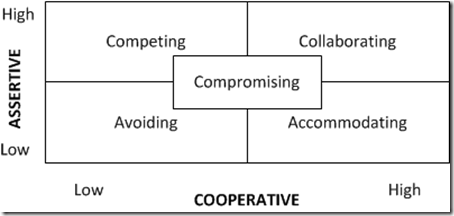Conflict resolution skills are required for a wide range of positions across many job sectors. This requirement is based around the fact that conflict tends to reduce productivity and create a difficult work environment, leading to unwanted turnover in staff and reduced morale.
Individuals who are able to resolve conflicts are often excellent mediators, rational, and able to manage difficult personalities from a place of empathy.
Conflict resolution is the process by which two or more parties reach a peaceful resolution to a dispute.
In the workplace, there can be a variety of types of conflict:
- Conflict may occur between co-workers, or between supervisors and subordinates, or between service providers and their clients or customers.
- Conflict can also occur between groups, such as management and the labor force, or between whole departments.
The Conflict Resolution Process
The resolution of conflicts in the workplace typically involves some or all of the following processes:
- Recognition by the parties involved that a problem exists.
- Mutual agreement to address the issue and find some resolution.
- An effort to understand the perspective and concerns of the opposing individual or group.
- Identifying changes in attitude, behavior, and approaches to work by both sides that will lessen negative feelings.
- Recognizing triggers to episodes of conflict.
- Interventions by third parties such as Human Resources representatives or higher level managers to mediate.
- A willingness by one or both parties to compromise.
- Agreement on a plan to address differences.
- Monitoring the impact of any agreements for change.
- Disciplining or terminating employees who resist efforts to defuse conflicts.
Kenneth Thomas and Ralph Kilmann developed five conflict resolution strategies that people use to handle conflict, including avoiding, defeating, compromising, accommodating, and collaborating.
This is based on the assumption that people choose how cooperative and how assertive to be in a conflict. It suggests that everyone has preferred ways of responding to conflict, but most of us use all methods under various circumstances. It is helpful to understand the five methods, particularly when you want to move a group forward.
Thomas-Kilmann Conflict Mode Instrument
The Thomas Kilmann Conflict Mode Instrument is a model for handling conflict:

Conflict Management Styles
Here are the five conflict management styles according to Thomas, K.W., and R.H. Kilmann:
- Accommodating
This is when you cooperate to a high-degree, and it may be at your own expense, and actually work against your own goals, objectives, and desired outcomes. This approach is effective when the other party is the expert or has a better solution. It can also be effective for preserving future relations with the other party.
- Avoiding
This is when you simply avoid the issue. You aren’t helping the other party reach their goals, and you aren’t assertively pursuing your own. This works when the issue is trivial or when you have no chance of winning. It can also be effective when the issue would be very costly. It’s also very effective when the atmosphere is emotionally charged and you need to create some space. Sometimes issues will resolve themselves, but “hope is not a strategy”, and, in general, avoiding is not a good long term strategy.
- Collaborating
This is where you partner or pair up with the other party to achieve both of your goals. This is how you break free of the “win-lose” paradigm and seek the “win-win.” This can be effective for complex scenarios where you need to find a novel solution.This can also mean re-framing the challenge to create a bigger space and room for everybody’s ideas. The downside is that it requires a high-degree of trust and reaching a consensus can require a lot of time and effort to get everybody on board and to synthesize all the ideas.
- Competing
This is the “win-lose” approach. You act in a very assertive way to achieve your goals, without seeking to cooperate with the other party, and it may be at the expense of the other party. his approach may be appropriate for emergencies when time is of the essence, or when you need quick, decisive action, and people are aware of and support the approach.
- Compromising
This is the “lose-lose” scenario where neither party really achieves what they want. This requires a moderate level of assertiveness and cooperation. It may be appropriate for scenarios where you need a temporary solution, or where both sides have equally important goals. The trap is to fall into compromising as an easy way out, when collaborating would produce a better solution.